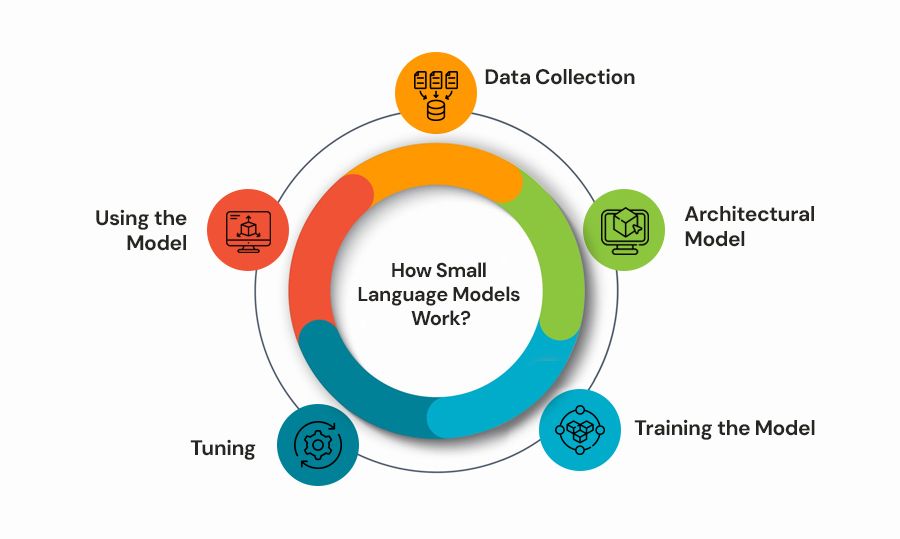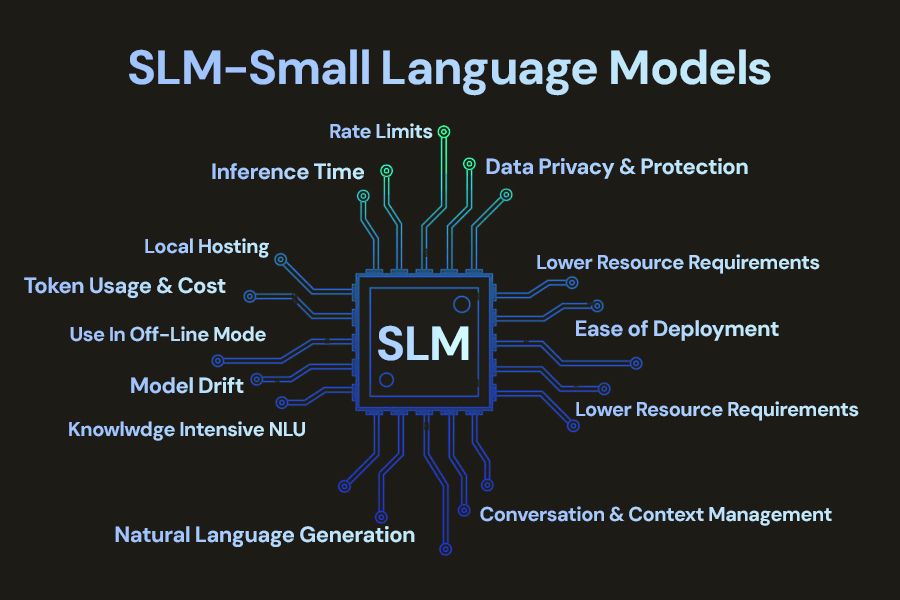
This is especially true for the field of artificial intelligence (AI), which has generated so-called large language models (LLMs), such as OpenAI’s GPT family or Google’s Bard. Yet, another trend is developing with these models, the Small Language Models (SLMs), as they take a moment and the complexity increases while their size seems to decrease, and they start to diverge. With a focus on embedding and deploying AI at lower levels of precision and latency, these small devices are changing the landscape of AI processing, providing hands-on capabilities and affordability in many fields.

What Are Small Language Models?
Small Language Models (SLMs) are AI-enabled models that are like larger models but with lower parameters, thereby making them lighter and better. SLMs, on the other hand, are different from start to finish rather than requiring huge infrastructure and untold quantities of data, they are tuned for a particular task (Or more accurately a class of tasks) and operate with less demand on overall resources.

Big Buzz About Small Language Models
1. Efficiency and Speed
As a result, the lower training time of SLMs makes them faster and more efficient for deployment in real-life systems since they require less computational resources compared to typical machine learning model. This ability of optimizing the speed to be crucial for the business who requires the AI solution but may not be looking forward to spending heavily on the hardware. For example, the customer service chatbot that runs on an SLM can generate responses on the fly, without the latency you would expect to see with larger models.
2. Lower Cost and Accessibility
Training and deploying large AI models can be resource-intensive and expensive, often needing to use high-end GPUs or cloud-based services. SLMs decrease these costs, thus allowing AI technology to be more available for smaller companies and independent developers alike. In other words, if you are a startup that is building a language-based AI assistant, then an SLM can easily become your friend without requiring a big investment in infrastructure.
3. On-Device Processing
These latter models also have a much smaller footprint which means that they can run directly on edge devices, such as mobile phones, tablets, and internet of things (IoT) gadgets, thereby reducing reliance on cloud computing and improving privacy and security. For instance, Apple’s focus on on-device processing for voice has enabled Siri experiences without the need to be connected to the internet all the time.
4. Customization and Adaptability
Largest models require extensive retraining for specific tasks whereas SLMs can be tuned for specific tasks. That makes them perfect for tailored applications like chatbots, content generation, and domain-specific automation. A law firm, for example, can use a specific SLM with fine-tuning on legal jargon only, to help with case law, without processing irrelevant data.
5. Climate Change Adaptation and Mitigation
SLMs consume fewer parameters compared to models which require large amounts of data. This is especially pertinent given the current emphasis on more sustainable AI solutions. AI service providers operating in the cloud can optimize their energy footprint by deploying SLMs in settings where they need not scale up to full-fledged LLMs.
6. Improved Data Privacy
The ability of SLMs to process data locally means they offer logic to reduce the need for sending sensitive information over the internet, jeopardizing a host of risks to your data and privacy. For instance, by utilizing SLM-based medical transcription services, patient data can be retained on secure local devices, rather than cloud-based servers.
What can Small Language Models Be Used for?
SLMs are being deployed across industries for a variety of use cases, for example:

Customer Support: SLMs help create chatbots that not only answer common questions but do so quickly without the high latency times and processing cost that comes with LLMs. One such case is Zendesk, which uses smaller AI-models for automated responses and guiding users to troubleshoot something. Also, companies can implement virtual assistants powered by SLM, providing instant customer support around the clock and relieving human agents. An SLM-based chatbot can help an organization like Airbnb navigate users through the process of changing their bookings or answering frequently asked questions, all without needing a human to get involved.
Healthcare: To help with medical documentation and patient interactions, SLMs can use context for in-depth information retrieval in support of disease prediction without violating industry standards for privacy compliance. The most popular use case is the deployment of a small AI model in a hospital to write summaries of doctor-patient conversations directly into electronic health records (EHRs). IBM Watson Health employs what are known as smaller AI models to read medical notes and assist doctors in diagnosing diseases more quickly. AI virtual health assistants like Ada Health assist patients with booking appointments, setting medication reminders and conducting initial health assessments based on symptoms.
Education: AI tutors and learning tools that are empowered by SLM can provide students with customized learning experiences. Take Duolingo, for instance, which leverages smart AI small models to allow users to progress through interactive language learning sessions. Google’s Read Along app uses a lean AI model to get kids to read with immediate feedback on their pronunciation.
Embedded Systems: The small form factor of SLMs makes them suitable for running AI models in smart devices, such as voice assistants and wearable electronics. Google’s SLM, for example, allows On Device Interpreter to process commands locally for its Assistant on-device voice recognition rather than in the cloud so you have improved privacy. S Samsung Bixby uses a small-scale AI model for offline functionality to carry out voice commands to control speech, such as being able to set reminders or send messages without being connected to the internet. Even in wearable devices eg. Apple Watch utilize SLMs for always-on real-time voice commands, health monitoring and predictive notifications.
Finance: SLMs can be used to help with fraud detection, customer transaction analysis, and automated report generation in financial institutions. For example, banks could adopt an SLM to study user spending trends and create customized budget suggestions. Similar AI models can help to identify transactional data with abnormalities, alerting to potentially fraudulent transactions by providers like American Express. Furthermore, AI financial advisory services based on SLMs (such as Wealth front and Betterment) provide collective analysis and assistance regarding investment preferences and savings plans (e.g., when to sell based on historical market trend patterns).
Retail & E-commerce: In the world of online stores, AI-powered product recommendation engines can utilize SLMs to make data-driven recommendations tailored to the user based on their vertical browsing history and past purchases, seamlessly and without the need for large cloud computations. Amazon’s recommendation engine is based on small AI models that offer personalized product recommendations based on previous user behaviours. Some online retailers will also implement SLMs behind AI-powered chatbots that help customers find products, handle returns and deliver personalized offers. For example, Sephora’s Virtual Assistant suggests beauty products by analysing users’ preferences and previous purchases.
Legal domain:
Law firms & Lawyers can use SLMs for summarizing long documents, extracting important insights, generating drafts of legal content. In addition, AI-driven SLMs could aid in contract review, detecting risk points, and confirming compliance with laws and regulations. For instance, ROSS Intelligence, a legal research tool powered by AI, aids lawyers in quickly searching for relevant case law with the aid of a small domain specific language model. Using small AI models to help you contest a parking ticket, claim refunds and wade through fearful legal jargon without needing any legal knowledge.
Manufacturing & Supply Chain:
AI-driven SLMs can improve supply-chain management by forecasting demand trends, optimizing inventory levels and automating logistics.They also help with quality control. Today's AI-driven SLMs, with on-line sensors placed at manufacturing units to collect data, pick up defects right then and there and in real time."They also employ AI models from Siemens to monitor how production lines are operating," reported the New York Times on May 21.Disney and IBM use SLM powered systems, which can detect when film has been processed. "Such precision sensing has been both efficient and accurate. What we're trying to do is minimize downtime. "UPS and FedEx, to give another example, are using SLM powered systems. These optimize delivery routes to save fuel and make break-evens pointers a powerful tool in improving logistics efficiency (Data collected on May 21 by the New York Times).
The Future of the Small Language Model
With the development of AI research accelerating, demands for solutions which are scalable and sustainable are also increasing. SLMs are a particularly important step in making AI more efficient, adaptable and open for use by all.By capitalizing on them advantages, businesses and developers can utilize the power of AI without having to bear an additional burden on their processing resources. Maybe the future of AI is not about building larger models but instead making smaller ones that are equally intelligent and capable. With advances in neural architecture and optimization techniques Small Language Models will bring in a new age of AI--one which places priority foremost everywhere first efficiency, second being convenient to work with but still usable for the real world.
Scale Smart with Small Language Models



